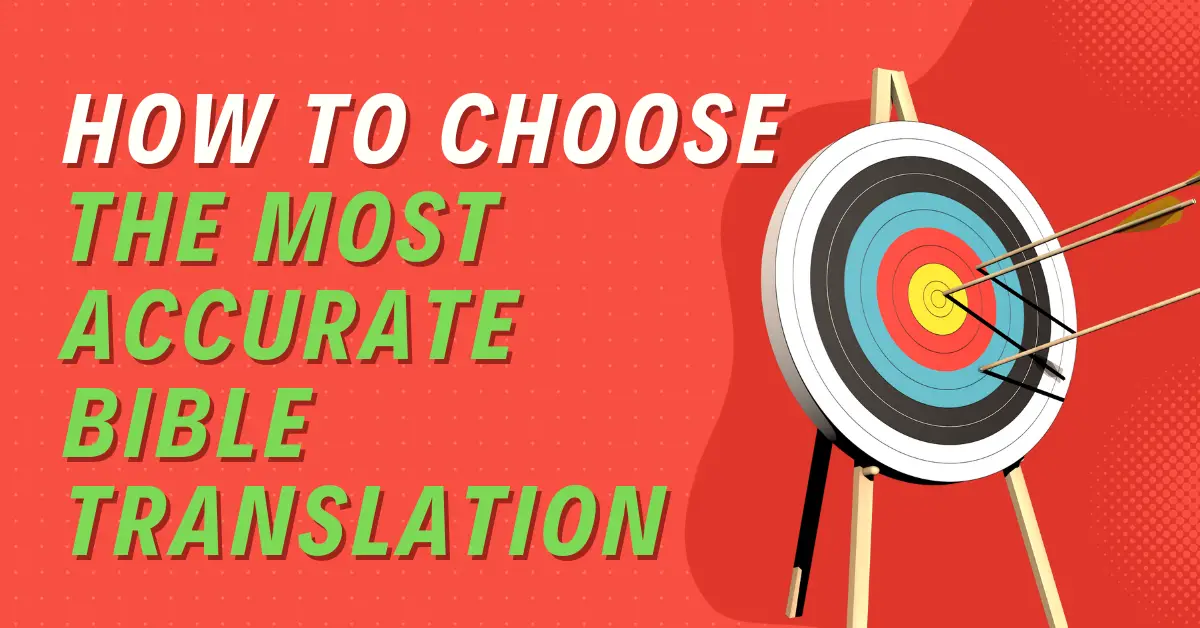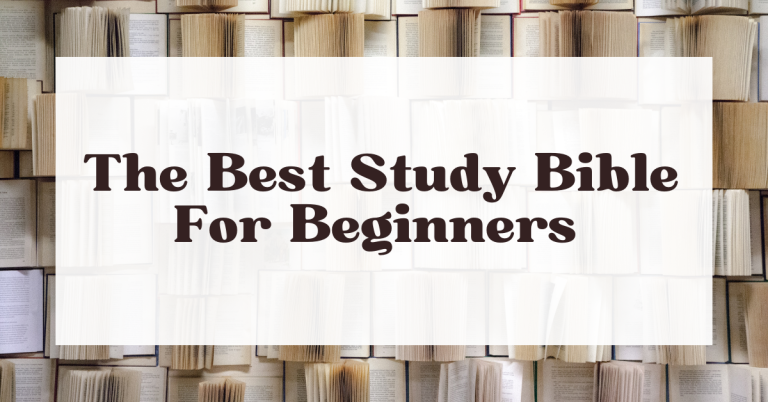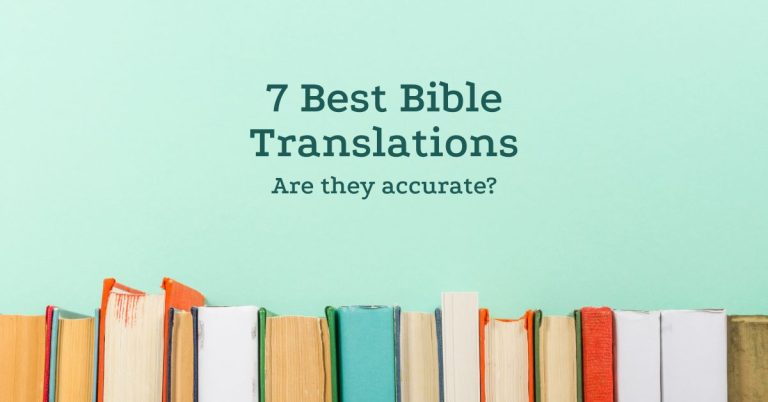How To Choose The Most Accurate Bible Translation In 2024
Do you struggle to choose the most accurate Bible translation for yourself?
If so, then you’re not alone.
In the history of Christianity, we have over 1000 translations of the Bible.
In the English-speaking world, we have hundreds of English Bible translations. There may be at least a dozen of English Bibles that Christians actively use today.
With so many Bible translations, it can be overwhelming. It is no wonder why the Bible is the best-selling book ever.
Having studied Bible translations as a pastor, I will provide points of consideration for choosing the most accurate translation that suits your needs.
Criteria For Choosing The Most Accurate Bible Translation
Most Faithful To The Original Languages
The most historically accurate Bible translation is found in the most faithful to the original languages.
It should capture – as much as possible – the authorial intent.
It should not capture man’s biases and opinions, which many bad Bible translations do.
A Balance In Clarity, Accuracy, And Readability
While accuracy is a must, a faithful Bible translation also balances clarity, beauty, and dignity to become readable for the audience.
The Reading Level
Each translation has different reading levels.
Depending on your reading level, it is best to choose one that is easy to understand while not losing the depth of the text.
Translation Team
English Bibles were translated by a team of bible translators who knew the nuance of the original language and the historical background.
Specific translation teams, such as Crossway, Thomas Nelson, and Zondervan, belong to particular publishers that publish Bible translations.
We cannot say who has the most accurate translator, but I doubt that they used machine translation!
Did they use translation software, translation tool, or translation services? I do not know.
Personal Preference
Having indicated the criteria, it comes down to preference.
Let’s face it. There is no such thing as the quintessential Bible translation.
Every translation has its pros and cons. It boils down to your needs.
Do you want a balance of accuracy and readability?
Do you want to study the Bible more in-depth and sacrifice readability?
The Top Five Most Accurate Bible Translations
Since the single and most accurate Bible translation cannot be found, there are many different Bible translations you can consider that are considered faithful and accurate to Greek and Hebrew.
New American Standard Bible (NASB)
Most biblical scholars agree that the New American Standard Bible is the most accurate English Bible translation.
The reason is that the New American Standard Bible strictly sticks to the literal translation method.
The New American Standard Bible was first published in 1971 by the Lockman Foundation. It was then revised in 1995. Some have suggested that the 1995 edition is the best version of the NASB.
Christians who use the New American Standard Bible come from an evangelical and conservative background.
The drawback is that it is not easy to read due to its literal strictness. The reading level may be a high school level.
English Standard Version (ESV)
The English Standard Version is personally my favourite Bible translation.
The English Standard Version is a literal and accurate translation that is most readable for modern readers.
The English Standard Version was published in 2001 by Crossway. Not only that, but it’s a revision of the Revised Standard Version (RSV).
Most Christians that use the English Standard Version seem to come from an evangelical, conservative, complementarian and reformed background.
King James Version (KJV)
The Original King James Version is one of the oldest English translations in the church’s history. It was at least 400 years old when King James authorized it in 1611.
Many theologians in church history have used the King James Version.
Some Christian fundamentalists hold to the King James Version tightly and dearly. They may consider it the only inspired word of God in the English-speaking world.
Nevertheless, the King James Version is excellent in its literary qualities, particularly the poetry in the book of Psalms.
The more you read the King James Version, the more likely you’ll pray in old English.
New King James Version (NKJV)
The New King James Version is an updated version of the KJV with modern English, while it aims to preserve literary qualities and structure.
Thomas Nelson published this translation in 1979.
I struggled to read the KJV, but the NKJV is much more readable.
Legacy Standard Bible (LSB)
The Legacy Standard Bible is a new Bible translation.
It’s a New American Standard Bible revision by Bible scholars from the Master’s Seminary. Afterwards, about 70 Bible scholars, pastors, and theologians reviewed this brand-new translation.
It aims at a new level of accuracy and precision in the original text. Not only that, but it also focuses on authorial intent.
For instance, it translates the personal name of God, “LORD,” to “Yahweh.” It translates “servant or bondservant” to “slave.”
Chances are, this might become the most accurate Bible translation.
I look forward to picking up a copy of the LSB.
BONUS: The Interlinear Bible
The Interlinear Bible is perhaps the most literal translation.
It reveals the words from the source language and their correspondence to the exact word from the target language. In other words, it is word for word correspondence.
It conserves the grammar of the original language, but it makes the reading weird in English.
The benefit of this translation is that you may notice how the original language originally arranged its sentence.
And it helps you to notice what the authors emphasize by looking at how they start the sentence.
If you desire the absolute most accurate Bible translation, Interlinear is considered one. However, be warned that the readability is not good.
What is a Bible translation?
A Bible translation is simply a version of the Bible that’s translated from the original language into a modern language. In this case, we’ll be focusing on the English language Bible Translation.
The Bible was not originally written in English. The original language of God’s word was Hebrew and Greek (and a bit of Aramaic).
But not everyone in the world can read those ancient languages. It is like asking a Korean to read The Art of War in Chinese without knowing the language.
The translation is necessary for fulfilling the Great Commission: “make disciples of all nations.” This phrase, “all nations,” means all ethnicities. The different ethnic backgrounds would have their unique language.
Do you know that Bible translation is still an active process in some parts of the world? Over 1,700 language groups are estimated to still not have a Bible.
Missionaries are still out there, living among these groups, learning their language. They are trying to compile and publish an appropriate translation of the Bible for those people!
Even Google Translate cannot do justice!
For further study, check out the books below.
Reasons You Need to Know About Bible Translations
Why is it essential for you to know about Bible translation?
We’ll give you five reasons because Bible translation can affect your Bible study and understanding of the Bible.
Translation Philosophy
There are generally three different philosophies of Bible translation.
Free Translation (Paraphrase Translations): It attempts to translate ideas from one language to another, with less concern about using the exact words of the original. A free translation, sometimes called a paraphrase, tries to eliminate as much of the historical differences (words, grammar, idioms, and matters of culture) between the original language and the receptor language.
Dynamic Equivalence (Thought-For-Thought Translations): It attempts to translate the original languages’ words, idioms, and grammatical constructions into precise equivalents in the receptor language. Translates phrase‐by‐phrase, trying to convey the sentence’s meaning into the receptor language.
Literal / Formal Equivalence (Word For Word Translations): It attempts to translate by keeping as close as possible to the exact words and phrasing in the original language, yet still making sense in the receptor language. Translates word‐for‐word, maintains the original word order, and translates individual words consistently throughout.
It is crucial to think through which translation philosophy you may be using. To answer the question of this post, you should pick a “word-for-word” translation.
Here is a Bible translation chart:
Accuracy
Mistranslation can lead to understanding and communication. It would be a disaster if the interpreter mistranslated the conversation in the European Union!
So, a Bible translation should be accurate to the original language. It should reflect the intent and meaning of the authors.
An accurate translation should ensure that God’s message is communicated clearly to all people in different languages.
Comprehension
Hebrew and Greek have their own grammatical rules. Those rules, however, cannot always be literally and directly translated word by word into another language.
For example, let’s translate John 3:16 word for word without modifying the style:
Οὕτως γὰρ ἠγάπησεν ὁ θεὸς τὸν κόσμον ὥστε τὸν υἱὸν τὸν μονογενῆ ἔδωκεν, ἵνα πᾶς ὁ πιστεύων εἰς αὐτὸν μὴ ἀπόληται ἀλλὰ ἔχῃ ζωὴν αἰώνιον.
This for love God the world that the son begotten he sent, that whoever the one believes in him will not die but have life eternal.
As you can see, the English grammar and style could be more comfortable.
A Bible translation should be understandable and accessible to the reader. By doing so, he can comprehend the message of Scripture.
Historical & Cultural Context
The authors wrote the Bible in their historical and cultural context. They use figures of speech and idiomatic language that the original audience would have understood.
For example, what does “gird up the loins” mean? Some English translations preserve the idiom, while others interpret the expression as “being ready for action or service.”
There are many examples of how translations preserve idioms. It can challenge readers to study and research the meaning.
But some translations (even if they are literal) would interpret the idiom’s meaning for the readers.
Spiritual Growth
Every Christian needs to read the Bible to be filled with the knowledge of God’s will.
If the translation is readable, it can help your growth.
For example, only some Christians can read and understand the King James Version with its archaic English.
But if the translation does not reflect the accuracy of the original language, it can lead you to misinterpret and misunderstand the text.
For example, in Psalm 8:4, the TNIV translated “man” to “mankind” as a more gender-neutral language. The problem is that it alters the original meaning and neglects the messianic significance.
What Are Good Options For Thought For Thought Translation
You can check out three translation: Christian Standard Bible, New International Version, and New Living Translation.
Conclusion
I have covered in this article some of the criteria to consider when choosing the most accurate Bible translation for yourself.
Choose the Bible translation that can help you read and study the Bible so that you can grow in the knowledge of God’s will.
We must learn to appreciate the laborious work of translators. They know the original language so that they can translate it into a language we can comprehend.





























One Comment